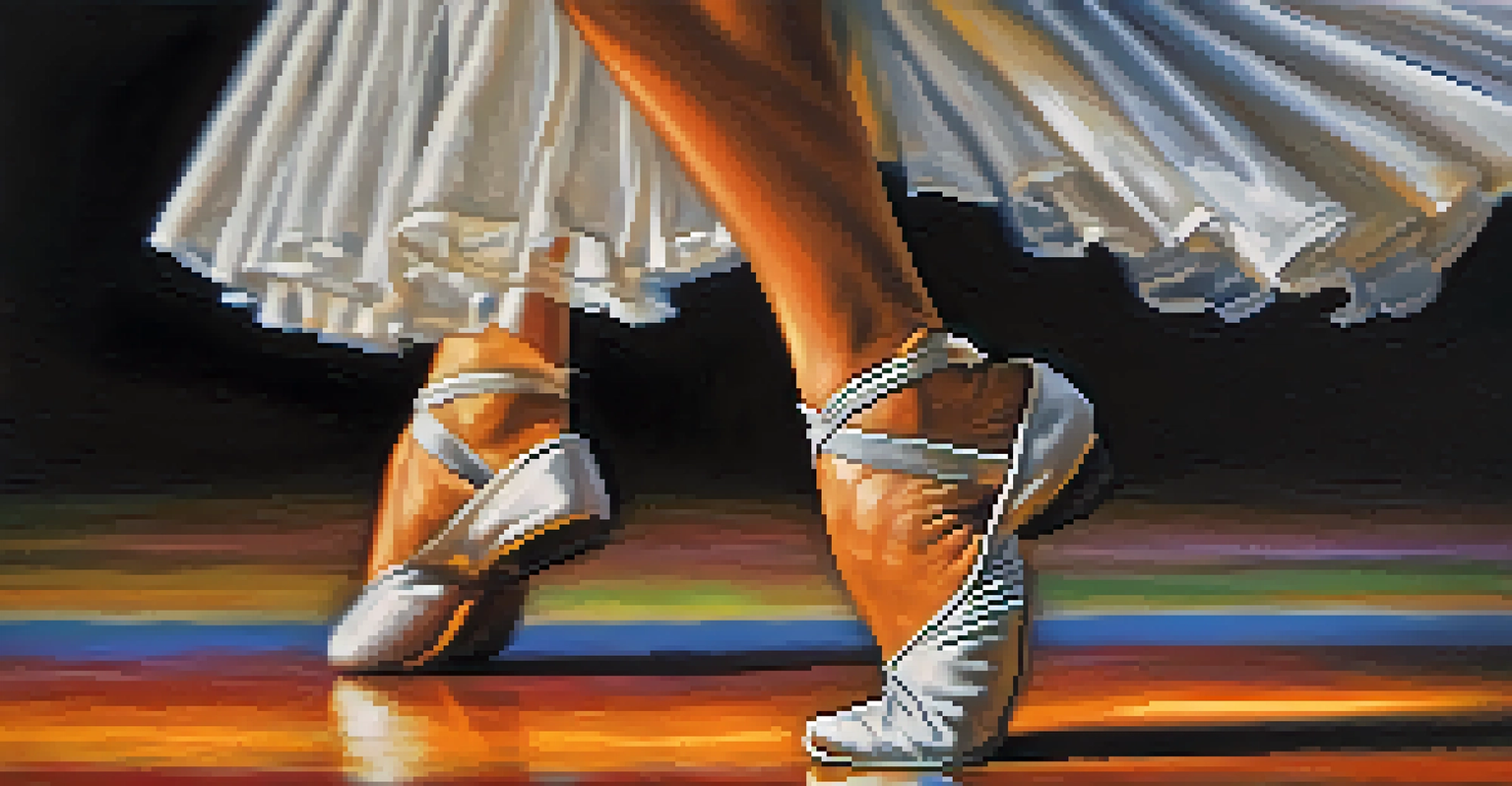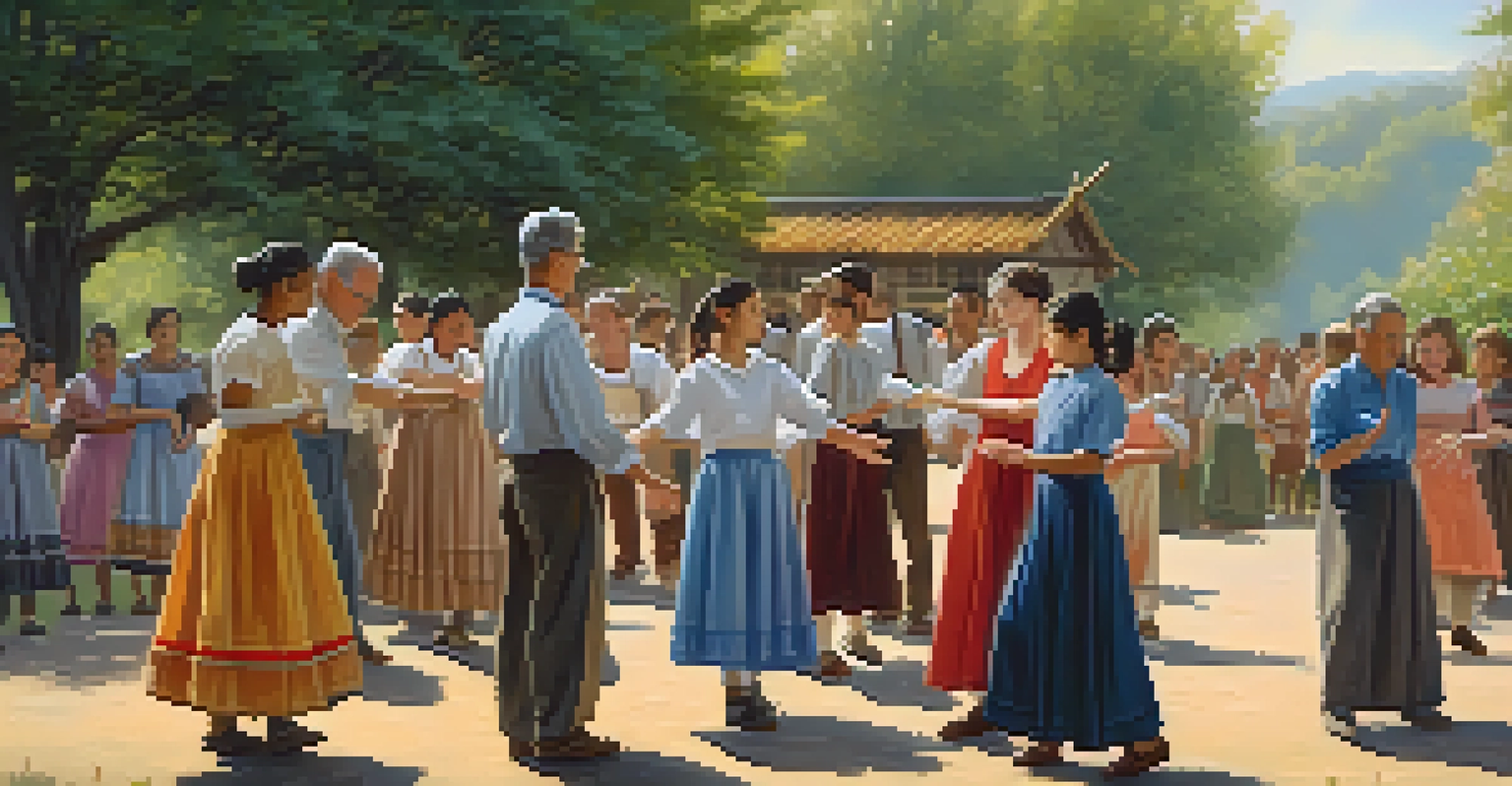Folk Dance Traditions: A Reflection of Cultural Heritage

What Are Folk Dances and Their Importance?
Folk dances are traditional dances that reflect the customs and heritage of a particular culture or community. They often tell stories, celebrate events, or express the values of the people. These dances serve as a window into the past, connecting generations through shared experiences and expressions.
Dance is the hidden language of the soul.
Historically, folk dances were performed during significant occasions like weddings, harvests, and festivals. Each movement and rhythm carries meaning, encapsulating the essence of a culture's beliefs and practices. This makes them not just a form of entertainment but also a vital part of cultural identity.
Related Resource
Furthermore, folk dances promote unity and community bonding. Participants often gather to practice and perform together, fostering a sense of belonging and pride in their shared heritage. In this way, folk dances become a living tradition, adapting yet preserving the core elements of their cultural roots.
Diverse Styles of Folk Dance Across the Globe
Folk dance traditions vary widely from region to region, each with unique styles and characteristics. For instance, the lively jigs and reels of Irish dance contrast sharply with the graceful movements of Indian classical dance forms like Kathak. These differences highlight the rich tapestry of global cultures, each telling its own story through dance.

In some cultures, folk dances are closely tied to specific instruments and music styles, enhancing their uniqueness. For example, the flamenco of Spain is often accompanied by passionate guitar and clapping, while ballet folklórico from Mexico blends traditional costumes with vibrant melodies. This interplay of music and dance further enriches the cultural experience.
Folk Dances Preserve Cultural Heritage
Folk dances act as living archives, passing down stories and traditions that connect generations and maintain cultural identity.
Moreover, as globalization increases, many folk dance traditions are blending, creating new forms that honor their roots while appealing to contemporary audiences. This evolution reflects the dynamic nature of culture itself, showing how tradition can adapt while still honoring its origins.
The Role of Folk Dance in Cultural Preservation
Folk dance plays a crucial role in preserving cultural heritage, acting as a living archive of a community's history. Through dance, stories of ancestors, historical events, and cultural values are passed down, ensuring that future generations remain connected to their roots. This preservation is especially important in an age where globalization threatens to dilute unique cultural identities.
The dance is a poem of which each movement is a word.
Communities often organize festivals and workshops to teach these dances to younger generations, ensuring that traditional movements and music are not lost. Such initiatives foster a sense of pride and appreciation for one's cultural heritage, while also encouraging participation in community activities. This hands-on experience is invaluable in keeping traditions alive.
Related Resource
Additionally, folk dance can serve as a form of resistance against cultural homogenization. By actively engaging in and celebrating their unique dance traditions, communities assert their identity and heritage in a world that often favors the mainstream. This act of preservation is not just about maintaining tradition; it's about celebrating diversity and resilience.
Folk Dance as a Tool for Social Change
Interestingly, folk dance has also been used as a tool for social change and activism. In many cultures, dance has provided a platform for addressing social issues, uniting people around common causes. Through performance, dancers can raise awareness about topics such as gender equality, environmental issues, and cultural rights.
For example, in the United States, Native American dance groups often perform to highlight the importance of preserving indigenous cultures and rights. These performances not only educate audiences but also empower communities to reclaim their narratives and identities. Dance, in this sense, becomes a form of protest and healing.
Folk Dance Promotes Social Unity
Participating in folk dances fosters community bonding and pride, bringing people together to celebrate shared heritage.
Moreover, folk dance can promote inclusivity, bringing together diverse groups to celebrate their differences. In multicultural societies, dance events that showcase various folk traditions can foster understanding and respect among different communities. This ability to unite people through art makes folk dance a powerful vehicle for social progress.
The Evolution of Folk Dance in Modern Society
As society evolves, so too do folk dance traditions, often blending with contemporary styles to create something new. Dance forms like hip-hop and contemporary ballet are increasingly incorporating traditional movements, creating a fusion that appeals to younger audiences. This evolution demonstrates the adaptability of folk dance and its relevance in today's world.
Social media has also played a significant role in this evolution, allowing dancers to share their performances globally. Folk dance videos can go viral, sparking interest in traditional forms among diverse audiences. This digital platform opens doors for cultural exchange and exploration, as people from different backgrounds engage with folk traditions.
Related Resource
However, this modernization raises questions about authenticity and preservation. As folk dances adapt, it’s essential to maintain the core elements that define their cultural significance. Striking a balance between innovation and tradition is crucial to ensure that the essence of folk dance remains intact.
The Impact of Technology on Folk Dance Traditions
Technology has revolutionized how we experience and participate in folk dance. From online tutorials to virtual festivals, technology allows enthusiasts to learn and connect without geographical limitations. This accessibility has broadened the reach of folk dance, inviting more people to explore and appreciate these cultural expressions.
Moreover, technology aids in documenting and preserving folk dance traditions. Video recordings can capture intricate movements and performances, creating a visual archive for future generations. This documentation not only serves as a learning tool but also helps keep the tradition alive, even as dances evolve over time.
Technology Transforms Folk Dance
Advancements in technology enhance the accessibility and preservation of folk dance, although they challenge the essence of live community experiences.
However, the reliance on technology also poses challenges. The essence of community gatherings and live performances, which are integral to folk dance, can be diminished in virtual spaces. It's essential to find ways to blend technology with traditional practices while still fostering the communal spirit that folk dance embodies.
Conclusion: Celebrating Folk Dance as Cultural Heritage
In conclusion, folk dance traditions are a vibrant reflection of cultural heritage, embodying the stories, values, and history of communities around the world. They serve not only as a form of artistic expression but also as a means of preserving identity and fostering social connections. Celebrating these traditions enriches our understanding of cultural diversity.
As we engage with folk dance, we are reminded of the importance of keeping these traditions alive. Whether through participation in local dance groups or attending cultural festivals, we play a role in ensuring that future generations can experience and appreciate this rich heritage.

Ultimately, folk dance is a celebration of life, community, and identity. By valuing and preserving these traditions, we honor our past while inspiring a more inclusive and vibrant future for all.